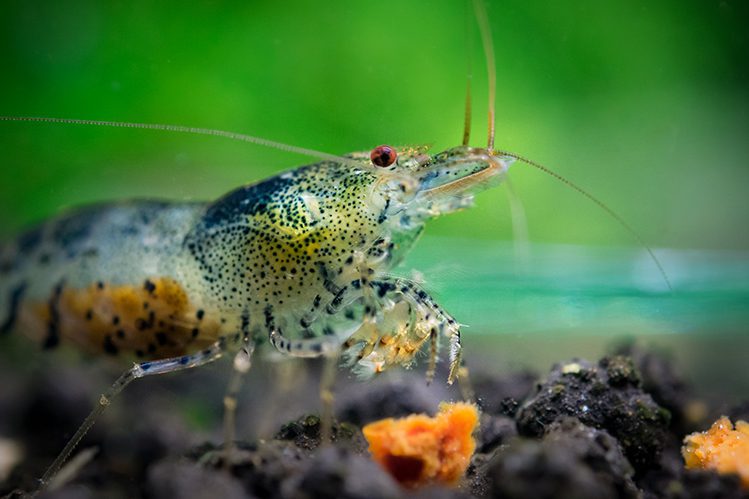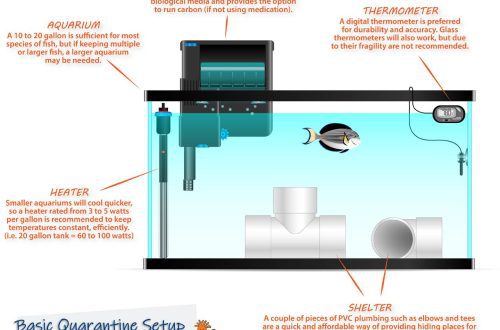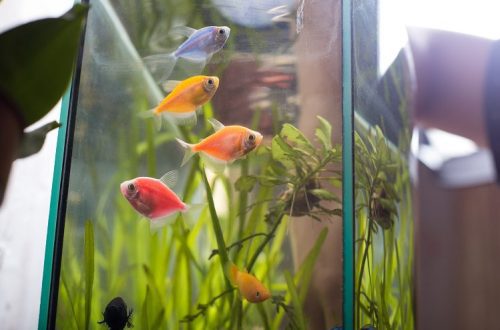
Keeping shrimp in an aquarium
When we talk about aquariums, the imagination draws an attractive underwater world with fish and plants. But the aquatic environment is inhabited not only by fish, but also by other interesting creatures. Many aquarists have already “tamed” freshwater and marine shrimp, the most skilled experts breed them. We have collected for you the main recommendations for the novice owner of a picturesque shrimp.
An aquarium with shrimp is often planted for beauty. Breeders have bred several types of shrimp of amazing color. Deep red cherry shrimp, black tiger shrimp are either entirely black or with a black body and orange eyes.
Shrimps are also known for their role as nurses in the underwater forest. They eat algae, bacteria, organic debris at the bottom of the aquarium. Amano shrimp are specially bred by the owners of herbalists so that the hydrobionts do the cleaning in the aquarium, which has begun to overgrow with algae. Red crystal shrimp also do a good job with bacterial growths on decor and driftwood. This penchant for cleanliness partly solves the question of what to feed the shrimp in the aquarium.
How do shrimp breed in an aquarium? Under comfortable living conditions, shrimp breed without any additional stimulating factors. Females are ready to give birth from about the age of five months. They send hormonal signals to shrimp of the opposite sex. Shortly after mating, eggs appear in the body of the female. After three or four weeks, you will see that the expanses of the aquarium plow the young. That is why it is advised to buy an aquarium “for growth” for shrimp. 10 shrimp can live in a ten-liter cube, but the imminent appearance of young ones will make the aquarium too cramped for them. Shrimp live, depending on the species, from one to four years.
Before you start arranging a shrimp and buying the aquatic creatures you like, answer an important question. Can you provide the necessary care and conditions for your new pets? Even if the exotic color of shrimp has become your love at first sight, find detailed information about their content. If your home is almost always cold, maintaining the right temperature for shrimp in an aquarium can be a challenge. It is better to foresee everything in advance.
The good news is that you won’t have any problems with what to feed the shrimp in the aquarium. They eat almost everything. When shrimp molt, shed their old shell, no need to catch it. The shrimp will eat it.
Shrimp should be fed once every two days in very moderate amounts. Overfeeding can seriously harm the health of shrimp and even lead to their death. Shrimps are suitable for fish food, but you can also buy special food for shrimp at the pet store. They will be helped to satisfy their hunger by slices of fresh cucumber, lettuce leaves, dry leaves of trees, for example, birch.

Many aquarium hobbyists prefer to keep shrimp in a separate tank without fish or other aquatic life. Shrimps are not settled alone, you can start with 10-15 individuals. Shrimps of different species usually live in the same aquarium peacefully and amicably, but it is advisable to keep shrimps of approximately the same size together. The exception is the macrobrachium shrimp, this species is not friendly, but is also suitable for keeping at home.
Shrimps can live in an aquarium with fish, although some experts are fundamentally against such a neighborhood. It is said that shrimp will hide from fish. But the fish can do the shrimp a good service. They will eat the nematode worms that plague the shrimp.
A small number of small, non-aggressive fish will harmoniously complement a shrimp aquarium. Shrimps coexist seamlessly in an aquarium with otocinclus fish, neon, killifish and rasboras are suitable.
You should not add newly purchased shrimp to your existing aquarium with fish. Shrimp are extremely sensitive to temperature and water quality. Many fish can perceive miniature creatures as food – the neighborhood must be carefully considered. Shrimp can get sucked into the water filtration system – an additional mesh is needed. Do not arrange such adventures for newcomers. Equip them with their own aquadom according to all the rules.
Beginners are advised to start keeping shrimp with more unpretentious species. Often these are cherry shrimp (also called cherry shrimp). Bright color will not let them get lost among the leaves and stones, pets will be in your sight. Cherries live at water temperatures from 16 to 28 degrees. They are suitable for water acidity (pH) from 6,5 to 8 and water hardness (kH) from 3 to 10.
Among experienced aquarists, there is a high interest in red crystal shrimp. This is also a miracle of selection. Neat red stripes on the white body of an inhabitant of the aquatic environment. They are more picky than cherry. The temperature of the water in the shrimp should be between 18 and 24 degrees. Zero kH and a pH of 6 to 7 are desirable. Water characteristics are best monitored using special drop tests.

Aquarium hobbyists emphasize that starting a shrimp tank is generally very similar to starting a regular aquarium. We start with laying out the soil. It is better to choose soil – a special soil for shrimp, which helps maintain an optimal pH level. Preferably dark soil – it is better to see the shrimp. Plant plants, arrange decor elements – stones, driftwood.
Do not overdo it with plants, in large quantities they can noticeably oxidize the water. Plants need a lot of light, and shrimp are not very fond of light. The main function of plants and decorations in a shrimp house is to serve as a shelter for your pets, especially during the molting season.
Fill the aquarium with water, connect the filter. Provide an additional mesh to the filter tube so that shrimp do not get there. If you do not want to wait a whole month, you can use an ampoule with a solution that contains beneficial bacteria. Pour the contents of the ampoule into the prepared shrimp tank, then the desired bacteria will inhabit it for about a week.
Separately, it must be said about the water for the shrimp. Experts advise using osmosis, that is, water purified from impurities by a water filter using the “reverse osmosis” technology. The same water is recommended for weekly water changes. Some shrimp owners say that 10% of the water needs to be replaced. Others are convinced that once a week you can change a third of the total volume of water in the aquarium.
Water should be enriched with minerals that will be useful for shrimp in the formation of a new shell during the molting period. Special salts for shrimp aquariums will help you here, the main thing is to follow the dosage. When changing water, minerals must also be added to fresh water.
When it is time to stock the shrimp, first add the aquarium water drop by drop to the one in which you brought them from the breeder. When the shrimp get used to, partially lower the container with them into the aquarium so that the new settlers can move into it themselves. We wish that your pets feel comfortable in the shrimp farm, and you can observe their life in the underwater world with interest.





